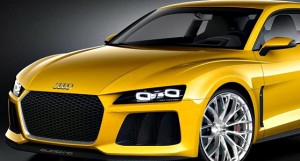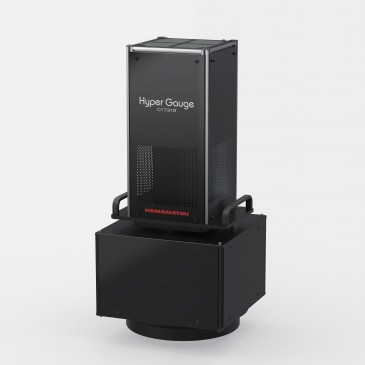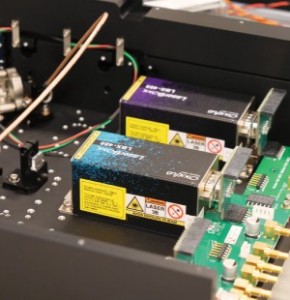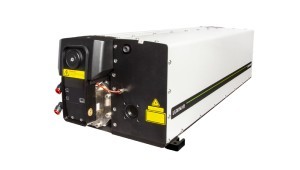
Over the past year, automakers Audi and BMW have both announced that they plan to offer vehicles equipped with headlamps featuring diode lasers as a source of light.
Currently it appears as if BMW will cross the finish line first with a production vehicle equipped with the laser technology. It has disclosed that its laser light system will be incorporated into its i8 plug-in hybrid sports car as an option when it goes on sale later this year.
Rival Audi, on the other hand, announced its intention to incorporate lasers into headlamps when it previewed the technology on an Audi Sport Quattro at the CES show in January 2013. The company will also be using laser lighting in its R18 Le Mans prototypes as auxiliary driving lights. However, it remains to be seen when the new lighting system will first make an appearance in headlamps in a production vehicle.
Today, many new vehicles are fitted with LED headlights, including those from Audi, BMW and Mercedes-Benz. So prevalent has LED technology become that, in December last year, Mercedes-Benz disclosed that it will be making a complete switch to LED lighting, and that its new S-Class will become the first vehicle in the world to do without a single light bulb as standard.
But just as LED lighting inexorably gains an increasing foothold in the automotive world, a new kid on the block has arrived that looks to complement it. And that lighting technology employs laser diodes to create a light source. In BMW’s new system, the laser-diode illumination system is used in conjunction with the LED headlamps to provide a boost to the range of the high beam.
According to Dr. John Bullough, a Senior Research Scientist at the Lighting Research Center at Rensselaer Polytechnic Institute in Troy, New York (US), both LED and laser diode headlamps are presently still relatively expensive, because they have not yet achieved the high volumes that will eventually bring about lower pricing.
But he notes that they do have some advantages. Because both LED and laser sources have higher efficiency in terms of "lumens per watt" than halogen lamps, they can produce more light per input power, which can result in greater amounts of light on the road which can create better forward visibility. Alternatively, they can use lower power, which puts less drain on the vehicle's electrical system.
According to Mercedes-Benz, LED low-beam headlamps that require just 34W are more efficient than halogen (120W) and xenon light bulbs (84W) while still able to produce the same equivalent light output. For its part, BMW claims that the new laser technology will increase that energy efficiency by a further 30%.
John Wilcox, a Senior Lecturer in Automotive and Transport Design at Coventry University (UK), says that the additional power that can be saved by deploying LED or laser lighting systems means that the effective range of the vehicle will be increased. He adds that this is especially important in the design of electric cars where designers need to save as much energy in the car as possible and reducing power to the lights is one important way to achieve that goal.
A semiconductor LED or laser light source may sport a lifetime of 30,000 hours; a lifetime that may exceed that of the car itself!
He adds that another advantage of both LEDs and lasers over conventional light sources such as halogen lamps is their reliability. Where a halogen lamp might have an edge over LEDs in terms of cost, its lifetime is likely to be only a few thousand hours, whereas a semiconductor LED or a laser light source may sport a lifetime of 30,000 hours; a lifetime that may exceed that of the car itself!
Laser light
In the BMW laser lighting system, the rays from three blue laser diodes are focused on to a yellow phosphor conversion module that is cooled to avoid the effects of local heating. The blue light absorbed by the phosphor layer is converted to yellow light, which is combined with blue light that passes through the phosphor layer to produce a broadband white light. The light is then is directed through the optical system of the headlight onto the surface of the road.
Stefan Weber, the Project Manager of BMW’s so-called “Laserlight project” acknowledges that the main advantage of the laser light source is that its luminance is ten times greater than that of an LED. While a typical high-powered LED chip might be 1 mm² in area, the area of a phosphor layer illuminated by blue laser diode might be only 0.3 mm² to produce the same amount of light. This makes it possible to shape a beam pattern with a relatively small optical element very precisely. Because the laser device is small, it also enables designers to build headlights that are more compact than today's models.
BMW used a combination of LED and blue lasers from Osram in the design of the new headlight. And when it introduces its laser headlights, Audi will be making use of laser diodes from the same manufacturer. Audi says that they are currently the only laser diodes available that meet automotive specifications on the world market. The company claims that the white light produced by the headlight has a colour temperature of 5,500 Kelvin, enables drivers to identify contrasts better, thus minimising fatigue.
BMW’s Weber says that his company used both LEDs and lasers because the company believes that while LEDs are best suited to provide a daytime running light, the laser produces an extremely focused light that can be directed with high precision. The laser light has enabled the company to boost the range of the beam from a vehicle to 600m, double the range that would be possible with LED lighting.
The relative size and efficiency of the LED or laser based headlights are not their only redeeming features. They also make it more straightforward for designers to develop what are known as "adaptive high beam" or "high beam assistant" systems. These high-beam systems use a camera that monitors the scene in front of the vehicle to identify the location of oncoming headlamps. The camera then instructs an engine control unit (ECU) to adjust the lights to meet specific driving conditions.
High-beam assistant systems switch the headlamps from high beam to low beam depending on whether another oncoming headlight is detected in the camera’s field of view. Adaptive high-beam systems, on the other hand, take advantage of the fact that individual LEDs arranged in a matrix can be activated and deactivated or dimmed individually. By doing so, the LED headlamps can produce high intensity light over the road, except in the specific location of an oncoming car.
Of course, as Dr. Bullough notes, it is possible to create this type of functionality mechanically with conventional headlamps. Indeed, such systems have been developed, but the advantage of using LEDs or laser diodes is that designers can do so without employing moving parts.
Legislation issues
At present, the National Highway Traffic Safety Administration (NHTSA) has approved the use of high beam assistant devices on automobiles in the US. Also, devices that swivel low beam headlamps based on steering are acceptable, too, because they do not change the beam pattern, only move it over to the left or right to better illuminate the road ahead. However, at present adaptive high beam systems are not permitted.
According to Dr. Bullough, that’s because when the standards which dictate beam patterns and intensity of light were written, it was assumed that the headlights would only perform either a low or a high beam function. A mostly-high-beam light with a dimmed portion that dynamically tracks and dims intensity in the location of oncoming vehicles as they pass by is, technically, neither a high nor a low beam and this is why they aren't permitted.
But Dr. Bullough says that NHTSA is not burying its head in the sand on the issue - the organization funded research at the Lighting Research Center to identify what properties of "adaptive high beam" systems would help maximize visibility while reducing glare.
NHTSA is actively investigating vehicles from Europe that have this functionality to understand how they affect drivers, and to see if the type of standards used in Europe and other countries might be suitable in the US, or if some other way of regulating them, might be suitable.
But it will take some time for standards to evolve, and NHTSA is required to address the impacts on driving safety. To help governments and industry understand these impacts, Dr. Bullough’s team has been evaluating the potential effects of adaptive high beam systems on nighttime crashes while driving, and, he says, there do seem to be real benefits.
Lighting styles
Aamer Mahmud, a colleague of John Wilcox, and the Course Director for Automotive Design and Vehicle Interiors at Coventry University emphases that the deployment of both LEDs and laser lighting technologies will have a profound impact on the styling of new vehicles.
He says manufacturers will race to create solid-state lighting that differentiates them from their competition and accentuate their brand identity. Indeed, it’s his belief that many customers considering purchasing a premium vehicle will come to expect such lighting technologies to be incorporated into them. In the high volume, less expensive automotive segment, however, the technologies could take a little longer to rear their head.
Mr. Mahmud adds that the new technology could open up new opportunities for designers to place the light sources themselves away from the front of the car and into the interior, routing light via fiber optic cables to the front and rear of the car.
One advantage with such a design is that the relatively expensive LED or laser automobile lighting systems would be more adequately protected from damage should an accident occur. As yet, however, none of the German automakers have disclosed plans to take such an approach, possibly Mr. Mahmud believes, because at the present time, they are taking a more conservative approach with less risk.
Written by Dave Wilson, Senior Editor, UK, Novus Light Technologies Today
































 Back to Enlightening Applications
Back to Enlightening Applications



























